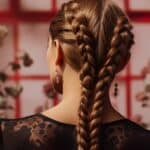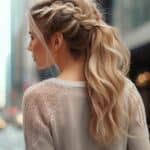Curly hair, a distinct and vibrant texture, is characterized by its wavy to coiled strands, creating patterns ranging from loose curls to tight spirals. Celebrated for its volume and dynamism, curly hair is influenced by genetics, humidity, and haircare practices. Its unique structure requires specialized care to maintain its natural bounce and minimize frizz. Dive deep into the curly hair world to discover its types, care routines, and beauty within each curl.
Curly hair, commonly known as Type 3 hair, is a beautiful and versatile type known for its distinct curl patterns. This hair type can range from loose, bouncy curls to tight and voluminous spirals, offering a unique aesthetic to those who have it. Type 3 curly hair is not only about its appearance; it also has specific care needs and characteristics that set it apart from other hair types.
Understanding the unique needs of Type 3 curly hair is essential for maintaining and enhancing its beauty. Knowing the right products and techniques is crucial to keep your curls looking their best. From choosing the perfect hairstyle to revitalizing dry or damaged hair, anyone with curly hair can learn how to care for their specific hair type. Type 3 curly hair can be nourished, healthy, and stunning with proper care and maintenance.
Key Takeaways
- Type 3 curly hair is diverse, ranging from loose curls to tight spirals
- Proper care and maintenance are essential for keeping curly hair healthy and beautiful
- Knowledge of specific hair products and techniques can help enhance and maintain Type 3 hair
Types of Curly Hair
Type 3 curly hair comprises three subcategories: 3A, 3B, and 3C. Each category has unique characteristics, allowing people to determine their hair type and style accordingly.
3A Curly Hair
3A curly hair is characterized by its large, loose curls that create an “S” shape. This hair type has a well-defined curl pattern, but the curls tend to be silky and more easily manageable. The hair strands are usually of medium thickness and naturally shine, making it relatively easy to maintain. However, it can be prone to frizz, so keeping the hair moisturized and using anti-frizz products will help maintain its appearance.
3B Curly Hair
3B curly hair features tighter and more voluminous curls than 3A, with a predominantly “S” shape pattern. The curls are bouncier and can vary in thickness, often giving the hair a fuller appearance. People with 3B hair type may experience frizz and dryness, so using moisture-rich hair products, such as leave-in conditioners and hair masks, is essential. A gentle cleansing routine is also recommended to prevent stripping the hair of natural oils.
3C Curly Hair
3C curly hair is characterized by its tight, corkscrew curls, which are densely packed and thicker than the other type 3 categories. The individual strands form a “Z” shape pattern, giving the hair a highly textured appearance. Due to its tight curl pattern, 3C hair is more susceptible to dryness, breakage, and frizz. Adopting a proper hair-care routine with regular deep conditioning treatments and using a wide-tooth comb for detangling can help maintain healthy, moisturized curls.
Unique Characteristics of Type 3 Curly Hair
Type 3 curly hair is known for its distinctive S-shaped curls ranging from loose, buoyant loops to tight, corkscrew shapes. This hair type has more volume and texture at the root than wavy hair but less so than coily hair. It can be easier to style than type 2 because the hair can hold its texture longer.
One of the critical characteristics of type 3 hair is its versatility. The curls can look and feel very different from person to person, which means that a wide range of products and styling techniques are available for individuals with this hair type. However, those with type 3 hair must keep their curls hydrated and well-nourished, as this type tends to be prone to frizz and dryness.
Type 3 curly hair can be categorized further into three subtypes:
- Type 3A: Large, loose curls form an ‘S’ pattern. The curls in type 3A hair tend to be shinier than their counterparts, but they may struggle with holding their shape throughout the day without proper care.
- Type 3B: The curls in this subtype are tighter and more well-defined. They can be springy and bouncy and have a mixture of both ringlets and corkscrew curls.
- Type 3C: This subtype consists of even tighter and denser curls. Curls in type 3C hair are sometimes referred to as “pencil curls” because they resemble the size of a pencil circumference. They may also be prone to shrinkage, which can be deceiving when assessing hair length.
With proper care and understanding of the unique characteristics of type 3 curly hair, individuals can embrace their natural texture and find the most suitable products and styling techniques for their specific curls. This will help maintain the health and beauty of their curls, ultimately allowing them to enjoy the best aspects of their unique hair type.
Hair Care Regime for Curly Hair
Curly hair has specific needs, and understanding how to care for it properly can make a world of difference. This section will discuss the three critical steps in a hair care regime for curly hair: Washing, Conditioning, and Drying.
Washing
Washing curly hair requires mild shampoos that don’t contain sulfates or other harsh cleansing agents. Choosing a shampoo formulated for curly hair is essential to ensure it receives the proper nutrients and care.
- Frequency: Curly hair should be washed every 2 to 3 days, as it is more prone to dryness and breakage. Washing too often can strip the hair of its natural oils.
- Technique: Gently massage shampoo into the scalp and hair, focusing on the roots. Be sure to rinse thoroughly, as residue can lead to build-up and dullness.
Conditioning
The tighter the curl, the drier the strand. Conditioning is crucial for maintaining the health and appearance of curly hair.
- Types: Use a high-quality, moisturizing conditioner specifically designed for curly hair. For those with very coarse or curly hair, a pre-shampoo treatment can help further lock in moisture and reduce frizz.
- Application: Apply conditioner to the mid-lengths and ends of the hair to avoid the roots to prevent greasiness. Leave on for the recommended time before rinsing.
Drying
Drying curly hair properly is essential for minimizing frizz and maintaining curl definition.
- Towel-drying: Opt for a microfiber towel or soft cotton T-shirt to gently squeeze out excess water. Avoid using a regular towel, as it can cause frizz and breakage.
- Air-drying: Whenever possible, allow hair to air-dry naturally, as this will help preserve the curl pattern and prevent heat damage.
- Diffusing: If a faster drying method is needed, use a hairdryer with a diffuser attachment on a low heat setting. This will help distribute the airflow evenly and maintain the natural curl shape.
By following these hair care practices, individuals with curly hair can maintain healthy, defined, and beautiful curls.
Best Hair Products for Type 3 Curly Hair
Type 3 curly hair requires specific products that provide adequate moisture and definition to maintain its beautiful curls. One highly recommended shampoo for 3a hair is Not Your Mother’s Sicilian Blood Orange & Black Currant Shampoo. This shampoo is available at Ulta Beauty and offers a gentle, hydrating cleanse that helps to bring out the natural curl pattern.
For 3c curls, focusing on moisturizing and lightly defining products like leave-in conditioners, oils, gels, and curl creams is essential. Cosmopolitan lists nine top-rated products for 3c curls that cater to various hair care needs.
When styling Type 3 curly hair, there are plenty of options. Naturally Curly features a comprehensive guide on the best hairstyles and products for Type 3 curly hair, including everyday hairstyles and tips on achieving them.
Remember that finding the products that work well on your curl type and hair care requirements is essential. These expert recommendations can be a great starting point for building your curly hair care routine.
Common Issues with Type 3 Curly Hair
Frizz
One common issue with Type 3 curly hair is frizz. Frizz occurs when the hair cuticle is raised, causing the hair to lose moisture and dry. This leads to a lack of definition and a frizzy appearance. A few ways to combat frizz in Type 3 curls include:
- Using a sulfate-free shampoo to prevent the stripping of natural oils
- Applying a moisturizing conditioner after shampooing
- Avoiding over-manipulation during styling, as this can cause breakage and frizz
Dryness
Another challenge with Type 3 hair is dryness. Curly hair has a naturally raised cuticle, making it more prone to losing moisture than straight hair. To help prevent dryness:
- Incorporate deep conditioning or hair mask treatments regularly
- Use leave-in conditioners or oil-based products to seal in moisture
- Avoid overusing heat-styling tools, as they can contribute to dryness
Hair Breakage
Lastly, Type 3 hair is more susceptible to breakage due to the spiral shape of the strands. The curls can wrap around each other, making detangling more complex and potentially leading to breakage. To minimize hair breakage:
- Detangle gently using a wide-tooth comb or your fingers, starting from the ends and working your way up
- Implement a moisturizing shampoo and conditioning routine to maintain the hair’s elasticity.
- Protect your curls by using a silk or satin pillowcase to reduce friction while sleeping.
By addressing these common issues, you can better maintain and care for your Type 3 curly hair, ensuring it stays healthy, manageable, and beautiful.
How to Enhance Your Curly Hair
Caring for type 3 curly hair involves mastering a routine that enhances your natural curls and maintains the health of your strands. Here’s a simple guide to making that happen.
First, finding the right hair products for type 3 curls is crucial. Opt for gentle shampoos or co-washes, ideally free from sulfates, to avoid drying out your curls. Washing your hair 2-3 times a week is recommended for optimal results.
Conditioning is equally essential for maintaining the health and appearance of type 3 hair. Including a conditioning step in your hair routine will help your curls retain moisture, preventing damage and breakage.
When drying your curls, use a microfiber towel or t-shirt to avoid causing friction, frizz, and damage to your hair. If you prefer a hairdryer, ensure you’re diffusing with low heat and high pressure. This will prevent heat damage, which can loosen your curls over time, especially for type 3A hair.
Styling products are vital for enhancing your curls. Applying generous curl-defining cream, gel, or mousse to your damp hair will boost its look and longevity. Scrunch the product into your hair from the tips working your way up toward the scalp.
Finally, allow your curls to air dry or diffuse them on low heat. If you’ve used a hard-hold gel, scrunch out the crunch once your hair is dehydrated. This will reveal soft, defined, and bouncy curls.
By incorporating these tips into your hair care routine, you can enhance the natural beauty of your type 3 curly hair and maintain its health and vibrancy.
Choosing a Hairstyle for Curly Hair
Curly hair comes in varying types, and finding the perfect hairstyle can be challenging. However, considering the specific subtype of your curls can make a significant difference. Type 3 curls are divided into three main subcategories, including 3a, 3b, and 3c.
Type 3a curls are generally loose, with large curls about the size of sidewalk chalk. These curls are usually easy to manage, and a simple yet stylish half-up, half-down hairstyle would work well with this hair type. To create this look, gather the upper half of your hair and secure it in a ponytail or bun, leaving the rest down to showcase your curls.
Type 3b curls are tighter and thicker than 3a, resembling the shape of a tapered candlestick. High volume is a definitive feature of this hair type, requiring hairstyles that accommodate the thick strands. An elegant option to consider is the Halo Updo, which involves twisting sections of the hair around the head, creating a halo-like effect. This protective style adds an element of sophistication to your look.
Type 3c curls are the tightest among the three, appearing similar to a pencil or straw in circumference. These curls require styles that embrace their unique shape and volume. One popular style for 3c hair is to use a pineapple method. To achieve this look, gather your curls on the top of your head and secure them with a soft scrunchie, allowing curls to cascade around your face effortlessly.
When choosing a hairstyle for your curly hair, consider factors such as your hair’s specific type, your preferred styling time, and the level of maintenance required. By understanding your unique curl pattern, you can confidently craft a hairstyle that complements your curls and reflects your style.
Tips to Prevent Damage to Curly Hair
Curly, precisely, Type 3 hair requires extra care and attention to keep it healthy and prevent damage. Here are some tips to help you maintain your curly locks:
Use gentle shampoos and conditioners – Select hair products specifically designed for curly hair. Products like DevaCare No-Poo, AG Re Curl Activating Conditioner, and Innersense Quiet Calm Curl Control work well for Type 3 hair. They help maintain the natural moisture balance and protect your hair against damage.
Detangle your hair with care – Use a wide-toothed comb or a Denman brush to detangle your hair, starting at the ends and working your way up. This helps prevent breakage and preserves your natural curl pattern.
Deep conditioning treatments – Since curly hair tends to be prone to dryness and frizz, it is essential to use deep conditioning treatments regularly. It helps maintain your hair’s moisture levels, keeping it soft, shiny, and healthy.
Avoid heat styling tools – Minimize using heat styling tools like straighteners and curling irons, as they can cause damage to curly hair. If heat styling is necessary, use a heat protectant spray to minimize the potential for damage.
Regular trims – To maintain healthy curly hair and minimize split ends, it is crucial to have regular trims. Incorporating trims into your hair care routine helps keep your curls in optimal shape.
Sleep on a satin or silk pillowcase – Traditional cotton pillowcases can cause friction, leading to frizz and breakage. A satin or silk pillowcase creates a smooth surface for your hair, reducing friction and preventing damage.
These simple but effective tips protect your curly hair from damage and keep it in its best possible condition.
Revitalising Dry or Damaged Curly Hair
Curly hair requires special care and attention to maintain its health and appearance. One of the main challenges people with curly hair face is dryness and damage due to various factors such as harsh chemicals, heat, and lack of proper hair care routine.
To help restore the moisture and health of curly hair, it’s essential to use products specifically designed for this hair type. One of the best treatments for dry and damaged curly hair is the DevaCurl Melt Into Moisture Matcha Green Tea Butter Conditioning Mask. This mask provides an intense surge of hydration, leaving the curls soft, manageable, and revitalized.
A proper hair care routine is also essential in preventing further damage to the hair. When washing and conditioning, it’s recommended to use cold water as it helps to close down the cuticle, ultimately ensuring that moisture is retained. Remember to gently detangle your curls using fingers or a wide-tooth comb to minimize breakage.
Additionally, avoid using regular towels to dry your hair, as they can cause friction, frizz, and damage to the curls. Instead, opt for a microfiber towel or a soft cotton T-shirt to gently absorb excess water without causing harm. Furthermore, when diffusing curly hair, low heat, and high pressure are advised to prevent heat damage, which can loosen the curls.
Finally, address the issue of dehydrated and damaged curly hair by treating it regularly with nourishing haircare products, such as deep conditioners, leave-in treatments, and hair oils. Be sure to give your curls the attention they deserve, and they will reward you with a healthier, more vibrant appearance.
Frequently Asked Questions
How to care for Type 3 curly hair?
Caring for Type 3 curly hair starts with using gentle, sulfate-free shampoos and nourishing conditioners to keep the hair moisturized and healthy. Maintaining proper moisture balance in your hair is essential, as it is prone to frizz when not moisturized. Additionally, using a wide-tooth comb or detangling brush can help prevent breakage and knots.
What products work best for 3A, 3B, and 3C curls?
Embrace lightweight stylers like creams, gels, and leave-in conditioners explicitly formulated for curly hair. Consider the best products for Type 3 hair that balance moisture and definition, such as those with natural oils and butter. The choice of specific products may vary based on the subtype and individual hair needs, so finding what works best for your hair is crucial.
How often should Type 3 curly hair be washed?
Washing frequency will depend on personal preferences and hair needs; however, washing Type 3 hair at least once a week is generally recommended. Overwashing can strip the natural oils from the hair, leading to dryness and frizz. If your hair needs a refresh between washes, consider using a lightweight, water-based refresher spray or co-washing with a gentle, silicone-free conditioner.
What techniques help define Type 3 curls?
Several techniques can be employed to define Type 3 curls, such as the popular raking and scrunching methods. Finger coiling, using a wide-tooth comb, or applying products using the “praying hands” technique are also effective ways to enhance your curl definition. After applying your styling product, consider diffusing your hair to encourage the body and bounce while minimally disturbing the curl pattern.
How can frizz be managed in Type 3 curly hair?
To manage frizz in Type 3 curly hair, ensure your hair maintains its moisture balance by using hydrating products and avoiding harsh, drying shampoos. Additionally, try incorporating regular deep conditioning treatments and sealing the hair cuticle with lightweight oils. You can also reduce frizz by drying your hair with a microfiber towel or t-shirt and handling your curls as little as possible once they have dried.
What is the best way to detangle Type 3 curly hair?
The ideal way to detangle Type 3 hair is to tackle it while it’s still wet and has a slippery conditioner applied. This approach makes working through knots and tangles easier without causing breakage. Use a wide-tooth comb or a detangling brush specifically designed for curly hair and start from the ends, working your way up to the roots. This method will prevent unnecessary tension on the hair and minimize damage.






